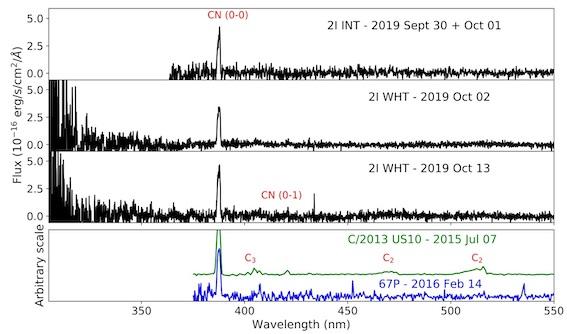2I/Borisov: A C2 depleted interstellar comet
Comet C/2019 Q4 (Borisov) was discovered on 30 August 2019 while cruising on an orbit with an eccentricity in excess of three. It is of unambiguous interstellar origin and was officially renamed 2I/Borisov on 24 September 2019.

Comet C/2019 Q4 (Borisov) was discovered on 30 August 2019 while cruising on an orbit with an eccentricity in excess of three. It is of unambiguous interstellar origin and was officially renamed 2I/Borisov on 24 September 2019. Unlike the first interstellar object 1I/2017 U1 (‘Oumuamua), which never showed direct evidence for a gas or dust coma, 2I/Borisov was already active at the time of discovery at 2.85 au. Additionally, its current approach to the Sun, with an expected perihelion on 8 December 2019 at 2.0 au, offers an unprecedented opportunity for the characterization of an interstellar body. Using spectroscopy as well as broad- and narrow-band imaging, Opitom et al. monitor the dust production rate and the recently discovered CN radical emission from the comet. Most significantly, the lack of C2 emission indicates a C2/CN ratio lower than 0.3. This implies that 2I/Borisov is C2-poor and suggests that it may have a composition similar to Solar System carbon-chain depleted comets. In the Solar System, C2-depleted comets make up about 30% of comets; a higher proportion of them are among Jupiter family comets originating in the Kuiper Belt than long-period comets, which come from the Oort cloud. Continuing observations in the coming weeks should better constrain the C2 content of 2I/Boris and more generally further characterize the composition of its nuclear ices.
Links:
2I/Borisov: A C2-depleted interstellar comet, C. Opit om, A. Fitzsimmons, et al., 2019, A&A, 632, L8
Astronomy & Astrophysics Highlighted paper 2019
Observing the intruder from interstellar space
New frontier for science as astronomers detect gas molecules in comet from another star

